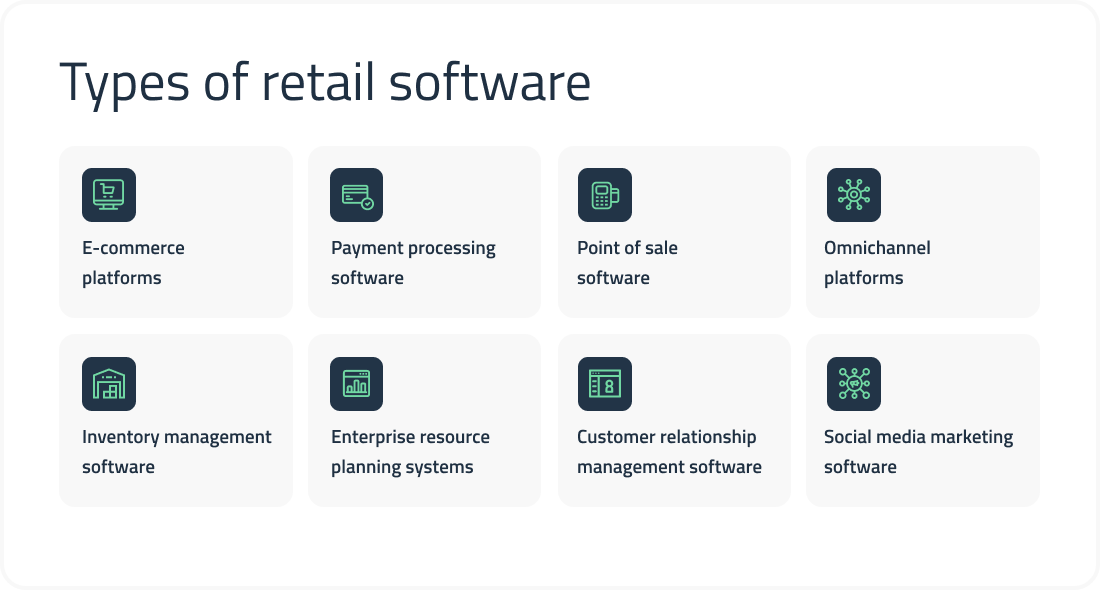

Retail industry software solutions: Types and technology trends
Retail was one of the first to change strategies and look for new approaches to stay afloat since the pandemic outburst. The fundamental factor was using the economic situation and the latest sales technologies.
DICEUS provides IT solutions for retail industry that enable retailers to meet current and future challenges. Let’s examine the types of these solutions, their advantages, and the promising trends that can efficiently help you retain old and attract new customers in such difficult times.
Apply for a free consultation on custom software development for retail.
What is retail software?
The ultimate goal of any sales business is to guarantee maximum satisfaction to customers and thus weather the storm of cut-throat competition in the niche. With the advent of across-the-board digitalization, it can be done only with the help of software used in retail stores (both offline and online ones) to keep track of their inventory, manage taxes, calculate salaries, define pricing, and do dozens of other coal-and-ice things that keep sales business’s cogs and wheels well-greased. These retail industry software solutions serve as potent tools honed to optimize all pipeline procedures, automate tasks that before were handled manually, expand their customer reach, and minimize human intervention.
To boost the efficiency of retail software, companies should have a clear vision of the use cases of the solution they are going to harness and select its type correspondingly.
Check out what services DICEUS offers for retail.
Types of retail software solutions
Functionally, software used in retail is classified into several distinct categories.

E-commerce platforms
Having exceeded the exorbitant $2 trillion in the first year of the pandemic (2020), the online sales industry stays on top of the most robustly developing sectors of the world economy. E-commerce solutions utilized to provide its smooth operation both for vendors and consumers include such features as a product catalog, inventory management, customer management, multi-channel marketing (with heavy stress on its e-mail variation), shopping cart, and payment gateway.
Payment processing software
Such solutions can be a part of e-commerce platforms or operate as standalone software with online and card payments, mobile wallets, bank reconciliation, customizable invoice templates, and other functionalities that guarantee seamless and secure financial transactions.
Point of sale software
Typically, a retail POS solution is utilized in brick-and-mortar outlets to handle on-the-spot payments. To do that, the solution makes use of a stock keeping unit module, in-store payment processing, inventory tracking, return management, and a self-service system for shops operating without a cashier.
Omnichannel platforms
This is a second-to-none means to manage both offline and online stores a brand owns with a web and mobile version of the latter. In addition to the conventional product and order management, shipping and return management, inventory handling, and payment gateways, such solutions with a highly customizable interface should take care of stringent data security and multicurrency support.
Inventory management software
Many retail outlets and – especially – warehouses utilize such solutions to monitor the goods they have in stock and their movement, relying heavily on product identification, stock-and-order synchronization, automatic invoicing, and expiry tracking. These characteristics of such solutions are highly instrumental when coupled with IoT technologies, including radio frequency identification (RFID) tags and barcode scanners.
Enterprise resource planning systems
ERPs are widely used by organizations in all industries, and retail companies are no exception. Alongside the basic staff, financial resources, and supply chain management modules providing end-to-end product management lifecycle, such solutions may be augmented by integrating a CRM (see below).
Customer relationship management software
With the overarching aim to increase efficiency through personalizing a company’s interactions with customers, CRM solutions contain social media monitoring, client analytics, and reports, sales forecasting, lead generation, and other modules. These modules enhance customer service by automating many shop floor operations and providing various third-party integrations.
Social media marketing systems
When most consumers lead an active virtual life in social networks, specialized software can reach out to them through posts and targeted campaigns. These are enabled thanks to content management, customer targeting, conversion tracking, and other functionalities. What are the best examples of retail industry software available on the contemporary digital market?
The top boxed retail software solutions
Each type of retail software has recognized leaders employed by thousands of enterprises worldwide.
Magento
It is one of the pace-setters in the domain of e-commerce platforms in Great Britain, Germany, and other countries, used by more than 250,000 e-stores globally. For a moderate monthly fee of $9.95, you will make use of this extremely customizable solution with a plethora of inventory management options. However, to make the most of it, you should possess some coding skills and be ready to splurge on extensions.
Shopify
Being not as popular as Magento, this platform nevertheless enjoys the reputation of a perfect one-stop-shop business model for $29 per month (and a two-week trial) with a user-friendly drag-and-drop interface and a huge theme range. Some of them, as well as the number of plugins, must be additionally paid for, though. Plus, the apps possessing minimal hard-wired functions may hamstring the platform’s efficiency.
Square for retail
This is an inventory management tool that is meant for optimizing the back-office and storefront procedures of a physical outlet. Its barcoding function, product identification feature, and plenty of other perks to boot are well worth the $60 per month for a location and only $20 for each new location you may open later.
QuickBooks
It is another inventory management solution, but its extensive roster of features and access from any device will primarily benefit large-size companies. By paying a yearly fee of $1213, they will be able to make extensive use of top-shelf accounting, time tracking, job costing, and other advanced functionalities.
Buffer
The tool is an excellent social media marketing solution that enables stories and hashtag planning, as well as Instagram tagging. For the paltry $15 a month, you will be able to manage up to eight social media accounts and publish a hundred posts on them.
Hootsuite
This social media marketing software costs a little higher ($19 per month), but it allows for ten accounts and a limitless number of posts. Moreover, Hootsuite paves the way for robust audience engagement with the scheduling and advertising analytics it provides.
Employing any of these will usher a number of boons for the retail organization that introduces them into its daily workflow.
Retail software advantages
Having profound expertise in retail solutions, we at DICEUS envisage the following benefits of adopting specialized software.
- Time efficiency. By automating the majority of routine and redundant tasks (like reporting, billing, payroll management, returns processing, etc.), you will be able to reduce the time spent on jobs where machines excel and direct human efforts to more critical assignments.
- Real-time access. Thanks to this software, all data and processes will be visible to you in the online mode so that you can immediately make data-driven decisions.
- Accuracy. No more mistakes and oversights caused by the human factor. No more underperformance because of sick leaves and vacations of your employees.
- Improved customer experience. All the benefits mentioned above translate into this one. With the clockwork organization of the workflow, your business will be able to satisfy its clients to the utmost and turn one-time buyers into loyal customers.
However, you can hardly make the most of retail software if you employ an off-the-shelf solution. Why?
Build vs. buy retail software
When you acquire off-the-shelf retail software, you instantly get a decently priced product with a basic set of functionalities that, once deployed, can be immediately put to its proper use. Being attractive at first glance, it doesn’t turn out that good after a closer look.
Since such solutions are meant for all and sundry, they end up being a perfect fit for nobody. They are sure to contain functionalities that you can do without (but have to pay for). On the flip side, they may lack the particular features you need. Besides, the integration and upscaling potential of boxed retail software is very limited, to put it mildly.
Thus, off-the-shelf retail products may satisfy a startup on short commons until it outgrows its size. For organizations that aspire to enter the major league of retail business, custom software is the only viable option. When you commission one, you can fill it with the functionalities meeting the unique needs of your company. While your organization expands its scope and reach, you can modify the bespoke retail product (which is your sole property) in any aspect you find necessary.
Top 5 technology trends for the retail industry
Digitalization and big data have opened up great prospects for all industries. IT technologies make it possible to achieve the unprecedented performance of trading platforms. And this is successfully used by the most ambitious entrepreneurs.
In mid-2021, research firm Gartner identified strategic trends to accelerate business growth, drive change, and build customer confidence. We consider the following to be the most significant:
- Contactless interaction with customers
- Rapid execution of orders
- Algorithmic optimization of merchandising and costs
Businesses need to be agile, and that requires a technology architecture that supports rapid, secure, and efficient change in tools and ways of working. Those who use composite applications (a software application with functionality taken from multiple sources) will outperform competitors in the speed of implementing new features.
Systems that enable hyper-automation will ensure sustainable business growth through rapid input identification, verification, and automation. By 2025, 60% of merchants are predicted to be using privacy-enhancing computing methods.
And the following advanced technologies will help those merchants achieve essential goals.

Trend 1 — Generative artificial intelligence
A new AI model is spreading on the market ─ a method of machine learning for neural networks to study and use data arrays to create unique content based on them. It can be used for code generation, new product identification, and targeted marketing, among other things.
According to the latest research, 77% of retailers plan to use AI in their business operations. However, this does not mean that robots will come to replace real employees. Instead, it’s about working with data to the fullest to improve business strategies and deliver personalized customer experiences.
Below are a few compelling use cases for AI in retail:
- “Smart” chatbots. Solutions understand human language and imitate a conversation with a real support employee. They can also identify user preferences and, based on them, offer new products or predict needs.
- Price regulation. AI visualizes the likely outcomes of multiple pricing strategies by gathering information about products, promotions, sales figures, etc.
- Price forecasting. Your customers know in advance how the price will change depending on fluctuations in demand, seasonal trends, product launch dates, and other characteristics. This will increase their loyalty.
- Search by photo. Allows you to upload images of your favorite products and find similar ones in your store.
- Virtual fitting room. The solution helps the customer find the perfect outfit in seconds.
The digital transformation of retail increases all business processes’ speed, efficiency, and accuracy. AI is at the heart of many ideas that have increased these numbers. Developers will now focus on composite applications focused on modular components, simplifying their tasks.
Trend 2 — Data fabric
This information management architecture is used to maximize access to corporate data. The solution simplifies the integration and scalable data architecture required for remote and hybrid distributed enterprise models. Organizations utilizing this work model will record an increase in revenue faster.
Trend 3 — Visualized (AR/VR) and voice commerce
Being able to review a product before buying is the best shopping experience. Such an opportunity has always been the prerogative of offline shopping, but now, everything is becoming completely different. The use of new technologies provides many advantages, including:
- Simplification of online shopping (for example, buyers can bring an item to life and see how it will look in a real environment
- Conducting contactless fitting
- Improved navigation in brick-and-mortar stores
- The ability to make personalized offers, for instance, directing customers to the right department
- Elimination of potential conflicts specific to offline stores for customers interested in personalized service (e.g., a virtual test drive of a car)
When it comes to voice commerce, according to Microsoft, 72% of potential buyers are already using voice search. Saying what you need is faster and easier than typing a query in the search bar. These forms of communication and interaction of the buyer with the shop windows will be further developed.
Trend 4 — Cybersecurity mesh
This novel solution provides secure access to any digital resource, regardless of user geography. It forms a defense perimeter around an individual, not around the entire organization. Gartner claims that by 2024, merchants that use such tools will be able to reduce the financial impact of possible cyber problems by an average of 90%.
We recommend doing this. As the threat of cyberattacks continues to rise, customers will place greater demands on their own security.
Trend 5 — Cloud platforms
Don’t forget the clouds. Cloud solutions have proven their effectiveness across industries, including retail. They are user-friendly and bring a lot of benefits to merchants. The leading cloud service providers for retailers are Google, Microsoft, Amazon, and Alibaba.
Analysts believe that retail is at the forefront of the use of cloud technologies. In addition to standard IaaS services (cloud data centers and various types of data storage), merchants began to use:
- Cloud solutions based on artificial intelligence (AIaaS)
- Big Data
- Data Science as a Service (DSaaS) products
- Platform as a Service (PaaS) and cloud SaaS applications are created on their basis
By 2025, cloud platforms are predicted to be the basis for over 95% of new digital initiatives. Autonomous systems that can dynamically change their own algorithms without updating external software will become commonplace in smart retail spaces.
Top promising retail directions
And now, let’s talk more specifically about the practical application of new technologies. To be more precise, about the most promising directions for the development of retail trade, in our opinion.
Personalization and tailored user experience
The main goal today is to make the buyer feel special, strengthening their brand loyalty. When they are not alone in their opinion about the product, it is easier for them to justify their own choice. Knowing your TA’s habits and preferences makes it easier for you to offer a product that best meets real-world requirements.
User experience becomes a driving factor in determining consumer choice. While companies used to compete in the overall quality of products and prices, currently – service, accessibility, ease of use, and sales force awareness are now coming to the fore. The design of outlets is important. However, this is not news to you. Only with the transition to online, this needs to be paid more attention to.
Experience-based retailing makes it as easy to provide personalized shopping as it is to buy goods online. CRM solutions help build competent interaction with customers. Surely, this is a topic for a separate discussion. Just try to choose one that can keep in touch and offer products and services that your customers really need.
Promotion via influencers
Retail needs to work with people who can influence the preferences and habits of the buyer. The audience trusts brands that advertise recognizable voices and faces. Why not use this to one’s benefit?
Since many brick-and-mortar stores are closed, customers can’t personally evaluate the products in the store, but a good video with famous people will help them. For an online store, opinion leaders can turn into growth drivers because there is just one click from an advertising post to a purchase. The main thing is to find the right influencer.
Omni-channel interactions
In retail, this approach focuses on providing a seamless customer experience. Whether they’re shopping through a mobile app, website, or the nearest store around the corner.
Most buyers use several sources of information when choosing products. They study it from all sides online before buying it in a regular store. Or vice versa, when they see it on a store shelf, they check information about it online. In addition to improving customer experience, this approach allows you to increase:
- Traffic and sales
- Customer loyalty
- Collected data quality
Omnichannel allows you to focus on the entire customer experience, rather than individual experiences across channels. Moreover, the topics of discussion in different segments may be different. Try to form your own groups, blogs, and other communities. Smartphone shopping will skyrocket, so retailers should consider connecting to popular mobile platforms or creating their own.
Social commerce
Already, Instagram, Facebook, and other communication networks have practically turned into shopping malls. Today, they play the role of marketing platforms for promoting brands and products. According to official data, social media sales for 2021 amounted to $36 billion, up 35% from a year earlier.
Such a boom is easy to explain: buyers do not feel alone, and therefore protected. They spend a lot of time on social media, and this trend is growing. New features that make shopping convenient and unique opportunities for attracting an audience create a powerful sales optimization tool. Social networks will do all the advertising for you. They will easily and simply allow you to bring a potential buyer to your landings.
Merchants can now create collections of featured products on their Instagram and Facebook storefronts, and customize the look of stores with banners, images, colors, and buttons. The same store can be accessed from two platforms, so a wide audience can be reached.
Contactless purchase and delivery
Today, shoppers want to shop safely and receive same-day purchases. You need to help customers, and thereby increase your own turnover. This is a general trend that includes several approaches:
Digital commerce
This includes online and brick-and-mortar stores with their own online version that allow you to shop remotely. The contactless chain here is not interrupted until the final delivery of the goods. You get more space to place goods and services. And your customers – more opportunities to get to know them and buy.
BOPIS and product take-out outlets
Customers place an order online or by phone and then meet with a company representative to pick up the purchase. At the same time, the buyer directly (personally) contacts only one employee.
The BOPIS approach allows customers to immediately pick up a pre-selected product at the checkout, instead of wasting time on tedious searching for goods and queues in stores. This minimizes the contact of interested parties, including buyers with each other, which is especially important during a pandemic.
Contactless payments
Paying with one touch or through mobile applications allows the buyer to minimize contact with the cash register or keyboard, which plays a big role in places with high traffic.
Selling through online trading platforms allows you to make a profit without high initial costs and launch your own online stores. One of the successful examples of such a marketplace is Amazon. According to statistics, more than 200 million visitors from 100 countries of the world make purchases here every month.
Amazon helps retailers promote their products and grow their customer base. You can quickly enter the global market with low marketing costs. You do not need to worry about the storage and delivery of goods, but you can use the reputation of the marketplace.
Autonomous delivery
Buyers want to receive the order as soon as possible and in the most convenient way. This is expensive to implement but extremely effective in attracting customers. It makes sense that many retailers are focusing their efforts on building offline delivery services. Amazon, Walmart, Target, and other giants are following this path. You should also think about reducing the time and simplifying the delivery methods.
Summary
Advanced technologies solve many business problems thanks to a number of useful data management and consolidation features. Some of them use machine learning algorithms, embedded artificial intelligence, and the Internet of Things. If you want to take your business to the next level, use them before your competitors!
For DICEUS as a qualified IT vendor, building custom software solutions is a bread-and-butter activity we excel at. Our highly competent team possesses the necessary skills and tech stack proficiency to develop a bespoke retail product of any complexity and feature roster that will amaze you with its seamless operation and affordable price.





